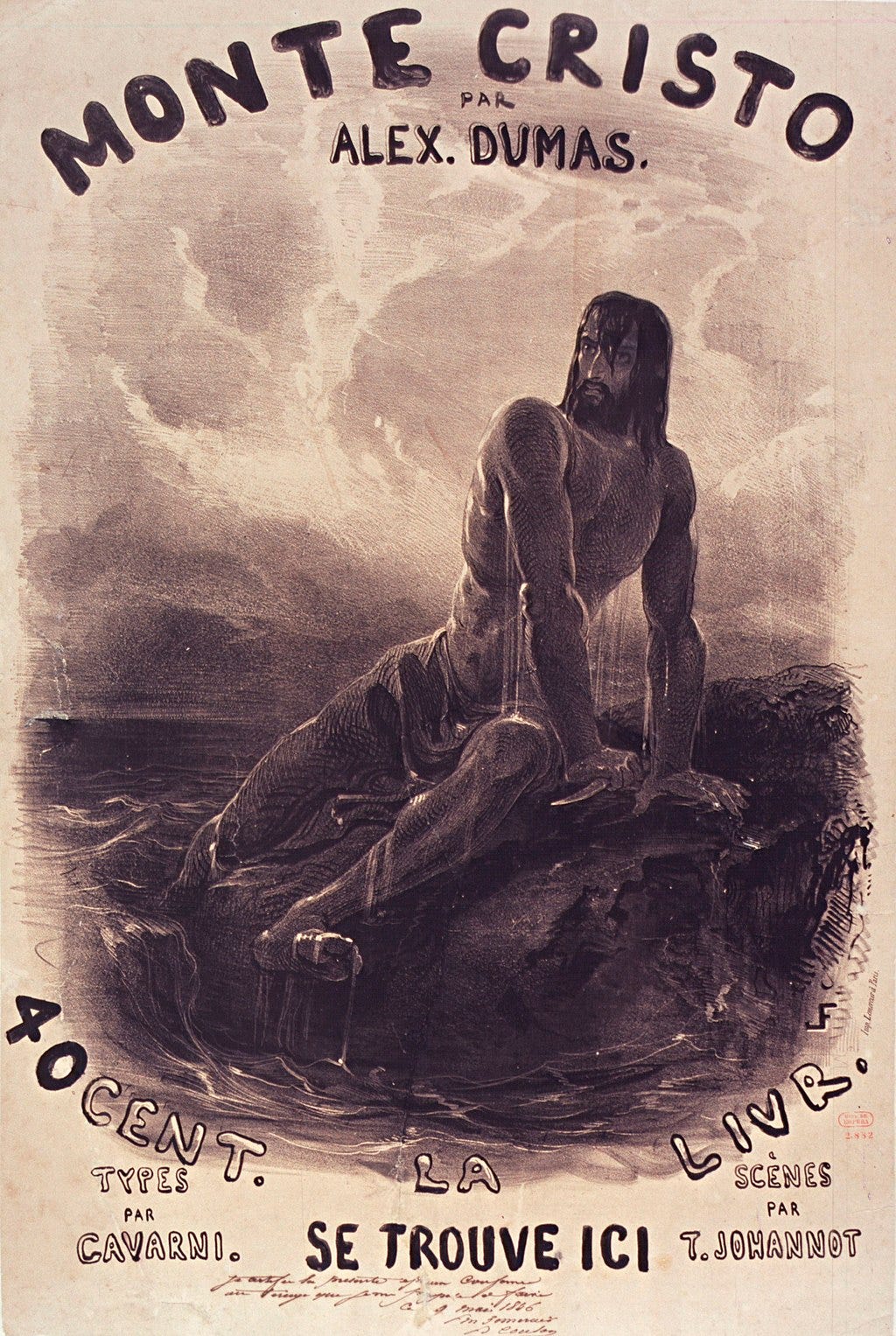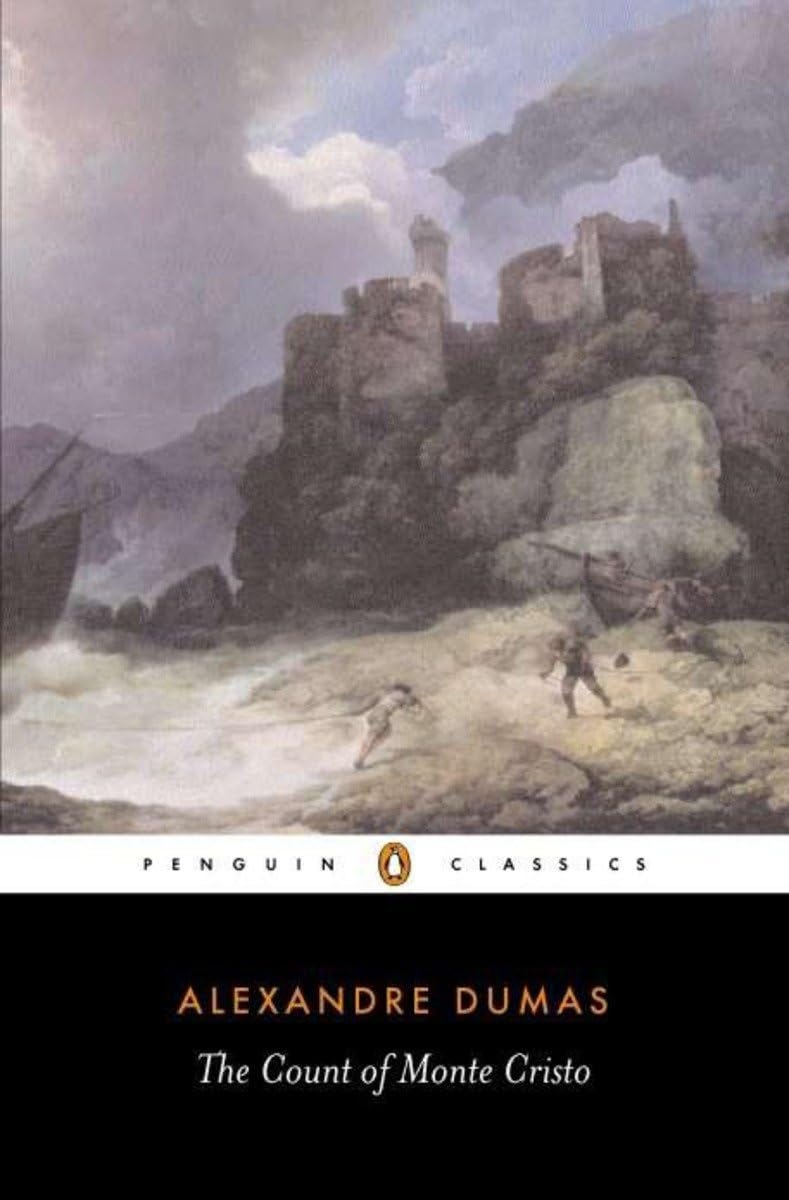Revenge, Redemption, and Resilience
Reading: The Count Of Monte Cristo by Alexandre Dumas
"The Count of Monte Cristo is of course one of the most gripping novels ever written and on the other hand one of the most badly written novels of all time and all literatures.” ___Umberto Eco
This is the way Umberto Eco opens his introduction to the Everyman’s Library edition of The Count of Monte Cristo, capturing perhaps the paradoxical nature of Alexandre Dumas' masterpiece. I will explain what I mean by this later, but first allow me a brief introduction of how I decided to read this incredibly long book.
For the past 15 or so years, my reading has been dominated by non-fiction, science, history, political theory and philosophy. I gained invaluable knowledge and learned to analyse, think critically and see connections between ideas.
But last year, I felt that something was missing. I craved something more than intellectual curiosity. I wanted stories that spoke to me, challenged, provoked and exhilarated me. Something that could offer not only knowledge and wisdom but the full range of human experience and complexity.
And so, I turned to the classics. “A classic,” said Mark Twain, “is something that everyone wants to have read, and nobody wants to read.” Determined to prove this sentiment wrong, I set a goal: In 2025 I will read one classic book each month. And for January I have chosen The Count of Monte Cristo by Alexander Dumas. A tale of betrayal, revenge, and redemption, which promises to be as exhilarating as it is thought-provoking.
Choosing what edition of the Count of Monte Cristo to read is not easy. There are countless translations both bridged or unabridged editions. After careful consideration, I chose the 1996 Penguin Classics edition translated by Robin Buss. It’s both complete and unabridged edition, spans over 1,200 pages and stays faithful to Dumas's original style. But it also presents the text in a more modern and accessible way, and more importantly, it restores – “entire and unexpurgated,” the content that was altered or omitted in earlier English translations due to Victorian-era sensibilities, such as references to Eugénie's lesbian Identity and Monte Cristo’s use of hashish.
There are, of course, bridged versions of less than 1000 pages and even 600 pages long but if you want my opinion, you should never read a bridge version of a book because you are not reading the book but someone’s summary of the book, which is kind of lame and lazy.
Being a huge fan of Umberto Eco’s work I also borrowed the Everyman’s Library edition from the Library, just to read his introduction (which I read after I finished the book). But enough with the introduction. It’s time to talk about the actual story.
The Count of Monte Cristo

Imagine this. You are 19 years old with your whole life ahead of you. You’ve just been promoted at work and you are ready to marry the love of your life. The future is bright, and full of promise.
And then, in a single, devastating moment, it all comes crashing down. You’re falsely accused and imprisoned, condemned to isolation in a desolate dungeon. Your youth, your life, is stolen, not by fate, but by the envy and treachery of a group of men who conspired against you.
After years of despair, you forge yourself. You meet a fellow prisoner, a brilliant man, who teaches you everything he knows and reveals the location of a treasure. After 14 years you escape. You are no longer the same person, you are reborn- hardened, driven and immensely rich. Now, you have only one purpose: revenge.
This is the story of The Count of Monte Cristo by Alexandre Dumas
“I don’t think man was meant to attain happiness so easily. Happiness is like those palaces in fairy tales whose gates are guarded by dragons: we must fight in order to conquer it.” __ Edmond Dantes, Chapter 117
It was published serially between 1844 and 1846 in a newspaper, capturing the imagination of readers week after week. For an extended period, it became the talk of Paris, a cultural sensation that dominated conversations and cemented its place as one of the most gripping stories of its time. Dumas was a prolific writer, he often worked on multiple stories simultaneously, producing a vast body of work that has captivated readers for generations. He also had collaborators, people who helped him with the historical research, today we call them ghostwriters. He allegedly worked for 14 hours a day, and during his life, he produced hundreds of books, including, plays, travel stories, historical novels and adventure stories, like the Count of Monte Cristo. One has to admire his work ethic.

So what can we say about the Monte Cristo? It’s romantic, moving, dramatic, adventurous. It's one of these books that you don’t want to end. You have reached the 1,230-something page and you wish to be longer.
There is clearly something in Monte Cristo that resonates with all of us, because since its publication the book has been reissued, re-translated and re-adapted endlessly. We all have felt like Edmond Dantes, the protagonist, at some point in our lives. We’ve all felt the sting of injustice, we’ve all felt trapped and the painful necessity to break free. I have certainly.
Life is a storm, my young friend. You will bask in the sunlight one moment, be shattered on the rocks the next. What makes you a man is what you do when that storm comes. You must look into that storm and shout as you did in Rome. Do your worst, for I will do mine! Then the fates will know you as we know you. __Edmond Dantès (as the Count of Monte Cristo); Chapter 117
It is one of the most captivating stories ever told, a tale of intricate plot, unparalleled suspense and riveting twists, that mesmerise readers. The first 300 pages are phenomenal. I can only compare them to the opening chapter of Moby Dick, which shares a similarly breathtaking brilliance.
The next 400 or so pages though with its melodramatic style, the repetitions and redundancies, can be frustrating and a little boring. Given that Dumas wrote it as a serialised work, it’s clear he was extending the narrative to sustain its publication, but the story could be shorter without losing any of its essence. However, as Umberto Eco suggests, the very elements some might view as imperfections are integral to the novel’s unique allure. These characteristics contribute to a narrative that remains as engaging today as it was when first published in 1844.
Although The Count of Monte Cristo explores philosophical and psychological themes, such as the nature of justice, the morality of vengeance, and the possibility of personal transformation, it's not a philosophical book in the sense that it does not go deep in exploring abstract ideas. Dumas seems more interested in captivating his readers with a story of human resilience, justice and redemption than offering answers to life’s grand questions. Instead, these themes are interwoven with the narrative adding complexity and depth to this epic adventure.
But, I think you said I have nothing to do. Now, I ask you, do you have anything to do? Or to put it more clearly, do you believe that what you do deserves to be something? __Edmond Dantès (as the Count of Monte Cristo)
Alexander Dumas's The Count of Monte Cristo has profoundly influenced literature, inspiring characters like Maurice Leblanc's Arsène Lupin and Arthur Conan Doyle's Sherlock Holmes. Lupin reflects the Count's mastery of disguise and intricate plots, while Holmes shares his keen analytical mind, transformative abilities, and, intriguingly, the occasional use of substances like hashish to expand perception.
“Nature wrestles with this divine substance, because our nature if not made for joy but clings to pain. Nature must be defeated in this struggle, reality must follow dreams; and then the dream will rule, will become the master and life become the a dream. What a difference is made by this transfiguration! When you compare the sorrows of real life to the pleasures of the imaginary one, you will never want to live again, only to dream for ever.” _The Conte of Monte Cristo on hashish.
This passage speaks to the timeless human tendency to escape pain and seek solace in imagined worlds. In our modern context, it resonates strongly with escapist phenomena, such as video games, which offer carefully designed experiences that allow players to escape their everyday struggles and create alternative realities where they can achieve, explore, dominate and feel joy on their own terms.

Finally, one cannot ignore the parallels between The Count of Monte Cristo and Alan Moore’s character of V and the overarching narrative of V for Vendetta. It’s not a coincidence that V’s favourite story and film is The Count of Monte Cristo. Like Edmond Dantes, V endures unimaginable suffering before seeking vengeance against a corrupt, totalitarian government. Both characters challenge us to question power and the lengths one should go to achieve justice and freedom.
This article is free to read, but if you found it useful, please consider subscribing or making a small donation at my Buy Me A Coffee page below. The Heretic Wotch is an independent publication, entirely supported by readers like you.





I loved your commentary on this novel! I just finished it a few weeks ago and just wrote a piece about it. I would love to hear your feedback! You know a novel is great when it compels you to write about it!
https://open.substack.com/pub/thomasobrien/p/a-novel-that-could-change-and-potentially?r=1wocq8&utm_campaign=post&utm_medium=web
Have a great day, I look forward to seeing all there is to come!